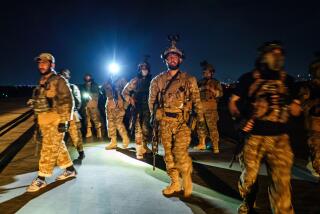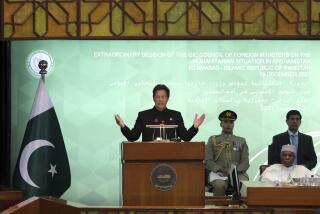More troops needed in Afghanistan, allies tell U.S. envoy
- Share via
KABUL, AFGHANISTAN, AND WASHINGTON — Allied military commanders in Afghanistan have told a senior U.S. envoy that they need more troops to deal with an intensifying insurgency in the country’s east, raising the possibility that the Obama administration may refocus the war on the lawless border with Pakistan.
Any request to increase overall troop levels to bolster forces in the east could face resistance from Congress, coming at a time when U.S. support for the war appears to be softening. A Washington Post-ABC News poll released last week showed that a slight majority of Americans now believe the war is not worth fighting.
Adm. Michael G. Mullen, appearing on television talk shows Sunday, noted with concern the diminishing support for the war among the public. He refused to say whether additional troops would be required but described Afghanistan as “serious and deteriorating.”
“Afghanistan is very vulnerable in terms of [the] Taliban and extremists taking over again, and I don’t think that threat’s going to go away,” he said.
Although American attention has focused primarily on the fight in southern Afghanistan, many senior U.S. military officials have come to the view that they need to step up the fight against Jalaluddin Haqqani and other insurgent leaders in mountainous eastern Afghanistan. They believe that a greater U.S. push there, combined with pressure from Pakistani troops on the other side of the border, could grind down the groups, several of which range between the two Asian nations.
Some military officials believe Haqqani has suffered setbacks because of Pakistani army pressure and is at a vulnerable moment.
“In the east we have an opportunity,” said an advisor to the U.S. command. “The Pakistanis have done damage to the Haqqani network.”
U.S. Army Maj. Gen. Curtis Scaparrotti, commander of forces in the east, told reporters traveling with U.S. envoy Richard C. Holbrooke on Sunday that Haqqani “is the central threat” in the east and that “he’s expanded that reach.”
Commanders with the North Atlantic Treaty Organization said Haqqani, who formerly centered his attacks in Afghanistan’s Khowst province, has been advancing farther afield, including as far south as southern Paktika province.
President Obama has already committed 21,000 additional U.S. troops to the campaign in Afghanistan, which will bring the American force to 68,000 by year’s end. About 30,000 international troops under NATO command are also deployed in Afghanistan.
American forces are suffering their highest death toll of the eight-year campaign, with 166 killed so far this year, according to the independent website icasualties.org. The deaths outpace the 155 killed in 2008, previously the most deadly year of the conflict for Americans.
The potential of stepped-up military activity in the east comes as Afghanistan awaits the results of Thursday’s presidential and provincial elections, with the possibility that a runoff race for president may be needed, continuing political tensions in the country for weeks.
Sen. Bob Casey (D-Pa.), visiting Afghanistan, said he told Afghan President Hamid Karzai, who is seeking reelection, in a meeting Sunday “that there’s going to come a time when the patience of Americans is going to run out.”
Holbrooke, who is the senior U.S. representative for Afghanistan and Pakistan, met with NATO commanders over the weekend.
Holbrooke has brought a new emphasis on the struggle against the insurgent groups in Pakistani mountain strongholds, believing that the nation is of top strategic interest to the United States even though the U.S. military contingent in Pakistan is dwarfed by that in Afghanistan.
Pakistan, with its own nuclear arsenal, is struggling to maintain its stability against a variety of insurgent groups, along with other crises.
There is no way to forecast how many troops the administration might add to the eastern region, but the addition of one brigade, or about 3,500 troops, would be a substantial increase. U.S. forces now have two Army brigades in the zone, plus some other personnel.
The addition of troops would mark a substantial refocusing of the fight.
Under the last NATO and U.S. commander, Gen. David D. McKiernan, the U.S. added one brigade in eastern Afghanistan, and the leadership was satisfied that troop levels there were sufficient.
Gen. Stanley A. McChrystal, the current NATO and U.S. commander, has questioned whether the fight in the south was as important to overall strategy as previously thought. He has suggested, however, that having more troops could be helpful in Kandahar, the home turf of the Taliban.
NATO has warned U.S. officials that the insurgent threat has expanded in other areas of the country as well.
Officers in the north have told U.S. officials that militants have aggressively expanded their reach in the Kunduz region, where they are attacking NATO supply lines.
James L. Jones, Obama’s national security advisor, has cautioned military commanders that it might be difficult to win administration approval of a larger troop deployment.
Several prominent Republican leaders, including Sens. John McCain of Arizona and Lindsey Graham of South Carolina, believe the United States needs more troops in both the south and the east. But there are also signs that Republican support too is softening in Congress, lawmakers say.
--
julian.barnes@latimes.com
More to Read
Sign up for Essential California
The most important California stories and recommendations in your inbox every morning.
You may occasionally receive promotional content from the Los Angeles Times.














